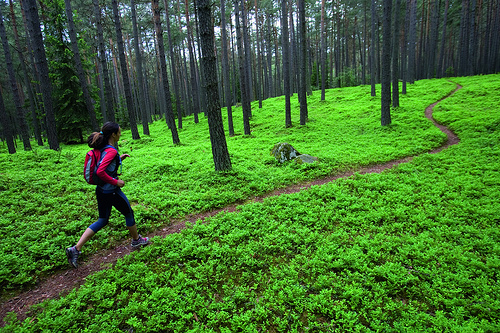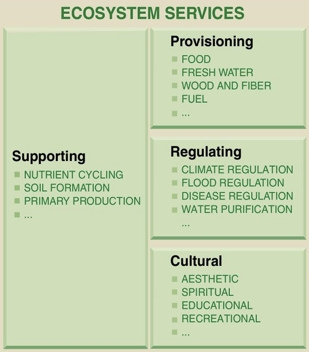
Photo by ergobachmann
Are you a fan of jogging through the woods? Buy a yearly forest pass: 1,780 Swiss Francs per person.
A 2005 study by the Swiss Federal Office for the Environment (FOEN) estimated the leisure value of Swiss forests to 10.5 billion Francs. This value estimation is based on the transportation costs to practice recreational activities plus costs of time spent in the forest for the Swiss population. While we’re used to pay our entrance fee to the pool, paying to access the forest sounds odd, right? After all, charging for something to which everyone has access to, such as a forest trail, conflicts with what economists call the exclusion principle. Yet, in addition to leisure, we benefit from other services from forests such as clean air, clean water, wood, harbor a diversified fauna and flora and regulate CO2 through photosynthesis and respiration. All for free.
A Global Study: TEEB
A similar study – The Economics of Ecosystems and Biodiversity – or TEEB, was carried out at the global level. Started in 2007 and lead by Deutsche Bank’s Pavan Sukhdev, TEEB produced six reports and is the result of a decision by governments of G8+5 countries to initiate the process of analyzing the global economic benefit of biological diversity, the costs of the loss of biodiversity and the failure to take protective measures versus the costs of effective conservation. Below are some highlights of TEEB’s findings:
- Conserving forests avoids greenhouse gas emissions worth US $3.7 trillion
- Global fisheries underperform by US $50 billion annually
- Bee keeping generates US $213 million annually in Switzerland
Using The Millennium Ecosystem Assessment
TEEB recognizes the link between nature and the economy using the concept of ecosystem services, or flows of value to human societies as a result of the state and quantity of natural capital. Ecosystem services have been defined by the Millennium Ecosystem Assessment which defined four categories of ecosystem services that contribute to human well-being, each underpinned by biodiversity.

Source: MA 2005
The Millennium Ecosystem Assessment (MA) was established by international organizations and a consortium of stakeholders policy-makers, civil servants, nongovernmental groups, indigenous people, business leaders, and scientists. It anticipated the need for a sound foundation of information on which decision-makers, both public and private, could base their actions. The approach used in the MA is described in Ecosystems and Human Well-being: A Framework for Assessment, which is also available on their web site. Four technical assessment reports were produced between 2001 and 2005 along with short syntheses that distill the overall findings.
The Diversity Behind The Services
In a services-oriented society, we should be familiar with the term service, e.g. catering services, medical services, telephone services, cleaning services, banking services, gardening services, etc. If want to manage services, we need to better define the term. There’s a discipline called Enterprise Architecture (EA) which helps here: EA identifies, maintains and develops knowledge of the enterprise’s purpose and structure. It is applied as lubricant between execution and strategy of the enterprise. Tom Graves, Principal at Tetradian, defines services as a capability which will be used to deliver a specific function or set of functions. Examples of capabilities in the enterprise are people, machines or IT systems. Examples of functions would be Accept Orders or Deliver Orders. Functions need to be related to capabilities to deliver services says the enterprise architect. Services can thus entail a large degree of diversity as the combinations of function and capabilities are multiple. It’s a little similar to soil types which are made of varying combinations of clay, silt and sand…
Biodiversity And Ecosystem Services
How does this definition of service apply to ecosystem services? Let’s take for instance Soil Formation which is identified as a supporting service in the MA taxonomy. One way to start the decomposition into functions and capabilities could be as follows.
Soil formation capabilities
- Multiple indigenous vegetation communities including grasses, forbs, trees
- Multiple preserved soil wildlife communities including bacteria, fungi, earthworms, and carabids (ground beetles)
Soil formation functions
- Prevention of land slides
- Provision of drinkable water
- Reduction of floods
- Maintenance of soil fertility (food provision)
- Resistance to climate change and invasive species
This type of decomposition helps understand the importance (and complexity stemming from the many capabilities) of diversity behind ecosystem services provided by our friendly nearby forest. From this simple way of looking at soil formation and its relation to the study of beetles, one realizes the importance of the work of specialists who track biodiversity across different environments. Ivan Löbl who held the position of curator and head of the Department of Entomology at the Natural History Museum in Geneva between 1992 and 1999 is one such expert. He participated at TEDxGeneva and his idea-worth-spreading was a warning against not only a loss in biodiversity but an extinction of experts due to lack of foresight needed to fund long, tedious but important research work. Environmental protection specialists resort to volunteers to compensate for the lack of experts and the lack of funds those experts would cost otherwise.
Enter Cognitive Surplus
Unless you have lived in a cave these past 4 years, you will have heard about social networks such as Facebook and how these technologies are affecting not only media but the way we do business in general. Charlene Li and Josh Bernoff had published Groundswell in 2008 in which they characterize a social trend in which people use technologies to get the orientation they need from each other instead of from companies. Jeff Howe publishes Crowdsourcing in 2009 which shows how people contribute their spare time to major projects including software development or citizen science. Clay Shirky of New York University publishes Cognitive Surplus: Creativity and Generosity in a Connected Age in 2010. He takes Howe’s argument further and shows how the shift from passive media consumption of the broadcast era to modern digital technologies leaves us with an untapped surplus of talent and goodwill. Shirky was invited at TED@Cannes and explains key ideas behind his book (13 Minutes).
Citizen Science
How does Shirky’s Cognitive Surplus translate in biodiversity and ecosystem services preservation? I’ll let Jeffrey Cohn answer with an excerpt of his article in Bioscience March 2008 Citizen Science: Can Volunteers Do Real Research?.
The term citizen scientists refers to volunteers who participate as field assistants in scientific studies. Citizen scientists help monitor wild animals and plants or other environmental markers, but they are not paid for their assistance, nor are they necessarily even scientists. Most are amateurs who volunteer to assist ecological research because they love the outdoors or are concerned about environmental trends and problems and want to do something about them. Typically, volunteers do not analyze data or write scientific papers, but they are essential to gathering the information on which studies are based.
I started tracking in a Google doc a list of projects in citizen science to get an idea of what’s being done out there. I looked specifically for biodiversity-related projects and left out others such as SETI@home which only involves loaning your computer’s computing power for a few minutes. The classification scheme of projects comes from Wiggins and Crowston and breaks down into 5 categories:
- Action
- Projects encourage participant intervention in local concerns, using scientific research as a tool to support civic agendas.
- Conservation
- Projects support stewardship and natural resource management goals, primarily in the area of ecology.
- Investigation
- Projects are focused on scientific research goals requiring data collection from the physical environment.
- Virtual
- Project activities are ICT-mediated with no physical elements whatsoever.
- Education
- Projects make education and outreach primary goals.
As solution architect in groundswell related technologies I noticed the following: few projects make use of mobile submission or hardware-based sensing e.g. Arduino. There’s no apparent common platform from which projects could benefit and simplify their setup and maintenance. Open data is another point that seems to be missing from most agendas: I refer to consuming the raw data directly from statistical software such as R by experts.
Citizen Wanted
Ask not what your ecosystem can do for you – ask what you can do for your ecosystem.
Chances are someone in your city or region thinks along these lines for biodiversity conservation based on existing national or supra-national initiatives. I’ll give two examples: one at the EU level and at the CBD level. Both share a focus on urban populations. Over 50% of the world population lives in cities (70% by 2050) and we can count on cities to keep increasing their overall ecological footprint.
The EU has a project since 2009 called European Capitals of Diversity. Its principal objective is to increase nature and biodiversity protection in urban areas and by local authorities in Europe until 2011. Specifically, this includes establishing a common Biodiversity monitoring system among participating municipalities and informing citizens about nature protection, conservation of biodiversity and the importance of their collaboration.
In May 2008, Singapore’s Minister Mah Bow Tan proposes to collaborate in developing a CBD-led City Biodiversity Index based on Ahmed Djoghlaf’s call for cities to share and pool knowledge on biodiversity conservation efforts. In February 2009, Singapore hosted the first expert workshop on the development of the city biodiversity index. The idea behind the Singapore Index is to:
- assist national governments and local authorities in benchmarking their biodiversity conservation efforts in the urban context
- help evaluate progress in reducing the rate of biodiversity loss in urban ecosystems
Way Forward
We have a sense of the importance of our surrounding ecosystems. Not just to clean our wastewater, but also for our leisure activities. There are experts watching over the functions and capabilities behind specific ecosystem services but there are not enough experts. Besides, the link between these capabilities and economic value is a quest that has barely begun and has not been tackled at the field-level. Volunteers a.k.a. Citizen Scientists can help and various organizations engage citizens in projects for conservation of our ecosystems. But there is a lot of room for improvement:
- Regulation
- To what extent is the data collected through volunteers used as auditing channel of environmental policies? Models
- Which conceptual models should be used for what project? Pressure-State-Response or Structure-Composition-Function? How does this relate to policy regulation? Platform
- Do environmental organizations benefit from a turnkey platform which lowers their setup and maintenance efforts, e.g. Ushahidi? Sensing
- Would projects benefit from hard sensing services based on open source hardware such as Arduino? What about mobile usage: should it be part of the platform offering?
What do you think? Let me know how this inspires you and in the meanwhile, I’ll complete the doc of projects in citizen science…
 This material is licensed under CC BY 4.0
This material is licensed under CC BY 4.0
